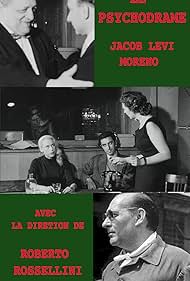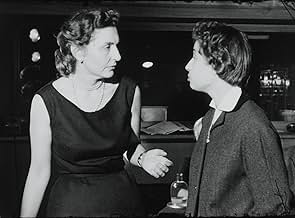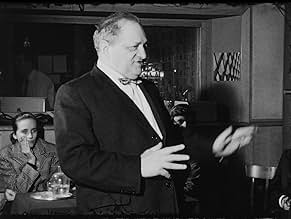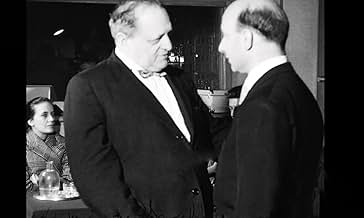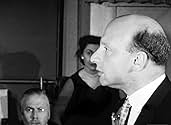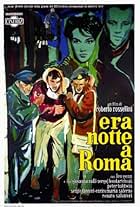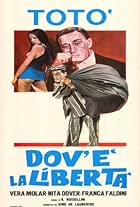Roberto Rossellini realized with Jacob Levi Moreno this short (not transmitted) for RTF. It is the prototype of Da Storia Nasce Storia (1991) by Ottavio Rosati broadcasted 35 years later by ... Read allRoberto Rossellini realized with Jacob Levi Moreno this short (not transmitted) for RTF. It is the prototype of Da Storia Nasce Storia (1991) by Ottavio Rosati broadcasted 35 years later by Italian TV Rai3. The historical meeting of 1956 was organized in Paris by A. A. Schutzenbe... Read allRoberto Rossellini realized with Jacob Levi Moreno this short (not transmitted) for RTF. It is the prototype of Da Storia Nasce Storia (1991) by Ottavio Rosati broadcasted 35 years later by Italian TV Rai3. The historical meeting of 1956 was organized in Paris by A. A. Schutzenberger and revealed to Roberto Rossellini a particularly congenial acting technique for a po... Read all
- Directors
- Writers
- All cast & crew
- Production, box office & more at IMDbPro
Storyline
Did you know
- TriviaIn 2018 Marco Greco, director of Torino Psychodrama Institute, found in France a video produced by RTF in 1956 (which everyone believed had disappeared) directed by Roberto Rossellini and filmed by a young Claude Lelouch about a psychodrama conducted by Jacob Levi Moreno in the spirit of the "Psychocinema" announced in his books. Also participating in this experiment is Anne Ancelin Schutzenberger, the student of Moreno who would become famous throughout the world for her research on the inter-generational transmission of the unconscious in families. In the video, Schutzenberger, during the conduction of a role playing, urged by RTF officials, often repeats the french words "Vite! Vite!" (Quick! Quick!) to speed up work times. The French expression "Vite! Vite!" (which in Italian also means "Lifes! Lifes!") is also present in a mysterious dream of Ottavio Rosati played in his Storia del treno e del passaggio a livello (2012) a psychodrama realized in Italy 35 years later, for the TV series Da Storia Nasce Storia (1991) produced by Italian television (Rai 3). It is the only story of the program that investigates the inter-generational unconscious. Here appears a phenomenon of synchronicity between two psychodrama experiments carried out by two television companies: RTF in 1956 and RAI in 1991.
- Quotes
Rosati in 2019: Your find is an extraordinary thing! You remind me of Aldo Carotenuto when he found the correspondence between Freud, Sabine Spielrein and Jung in Geneva. The result was "Diary of a secret symmetry". That book made it clear that without the weaknesses and the genius of these three characters the concept of transference, which today is obvious to us, would never have been born.
Greco in 2019: As far as Psychodrame is concerned, this film has been sought for years by psychodramatists and cinephiles. And it is thanks to the Anne Ancelin Schützenberger archive, that this could have happened, through the reorganization of which our association that is entrusted with it in Turin is working. During the cataloging we gathered some clues, some traces that led to Paris...
Rosati in 2019: With Rai3 in 1990 we looked for this video through Claudio Bondì, the television director of our "Da Storia Nasce Storia", who had been a pupil of Rossellini. But we didn't find it. How did you do it?
Greco in 2019: With the collaboration of Hélène Schützenberger, daughter of Anne, who, with the data we collected to identify it, requested the video of the INA in person, pointing out that her mother was one of the protagonists of the film. This may have been the key. What kind of key they used is not known to us... Perhaps it had been archived with old parameters. This is an experimental film shot in 1956 and not shown.
Rosati in 2019: The RTF could not perhaps broadcast such a complicated recovery but it has the merit of having organized the meeting between two directors / thinkers who were revolutionizing psychology and cinema. Even if it does not derive a creative collaboration but a reciprocal encumbrance. As if Hitchcock were to conduct a Gandhi conference aboard a train on the short Turin-Milan route. It is still something mythical.
Greco in 2019: Indeed,RTF, the France Radio Television, was a prestigious producer, but they offered Rossellini a very unsuitable set for the complex experiment to help the spontaneity of the actors grappling with the mechanism of television shooting: a challenge more than difficult. All this translates into a few improvised minutes in a rather crowded room with no lights... And the expression "Vite! Vite!", on the lips of Anne Schützenberger, watching her clock, is the refrain that underlines the need to hurry because there is no more time.
Rosati in 2019: Indeed. It is easy to see jumps and inconsistencies in the conduct of Moreno and Schützenberger who always watches the clock. But it is easy just because we are "Dwarfs on the shoulders of Giants" as Bernardo di Chartes says.
Greco in 2019: In the movie we immediately notice that there was no real group, according to our standards, nor an initial warming up of the people, or a preparation of the context; Schützenberger, perhaps safer because she already knows the environment and the language, mentions a definition of the set, making the scene build around a desk. However, the public is not used to dub, for example, or role reversals.
Rosati in 2019: While in "Psychodrama of a Marriage" by Moreno filmed at the Sorbonne in 1964 there is much of what he did at his Beacon's Theater in America as a director of psychodrama. There Moreno is at his best: charismatic but not directive. Instead, entering the studio of the RTF Moreno enters the wolf's den, in a futuristic factory of Cultural Conserves. He is working in the house of the enemy/friend: the Cultural Conserve producers.
Greco in 2019: The conduct of the protagonist also appears particular. As well as the definition of the arguments, as they arose... Topics that are, moreover, those of the attention of Man for politics, which is an active, creative interest, as he would say, for the Other... up to the entire Humanity that it can be saved only by deciding to focus on relational and creative mutual attention. Perhaps this is also why the distinction between him and the people he works with here appears more nuanced than usual.
Rosati in 2019: The theme of the father and of prayer, in the scene with the actor of Hungarian origin seem to be induced by a projective identification made by Moreno. At the beginning the actor protests against his father who forces him to pray and then without any elaboration embodies him as if he were offering his son an ideal mirroring. More than a psychodrama it seems to me like the staging of Moreno's book "The Words of Father". Everything happens under the gaze of Rossellini who in 1956 had already made "Roma città aperta", "Germania anno zero", "Giovanna d'Arco al rogo", "Viaggio in Italia".
Greco in 2019: Brilliant inventors who took advantage of the opportunity to experiment with each other... Moreno, moreover, wrote a document on the television medium in his manual, from which we deduce a singular level of competence on television, even at the technical level.
Rosati in 2019: It is the nucleus of a revolution that was about to change the world: the expansion of groups through networks. Not just television. Moreno did not invent Internet but he sensed it. He was its Prophet.
Greco in 2019: It is also on these issues that the movie questions us: the prophecy of a communication which widely spreads education and solicits rich relationships in creativity and spontaneity. In the end, how much has become a reality?
- ConnectionsRemade as Psychodrame d'un mariage (1964)
User reviews
Details
- Release date
- Country of origin
- Language
- Also known as
- Vite! Vite!
- Production company
- See more company credits at IMDbPro
- Color
Contribute to this page

